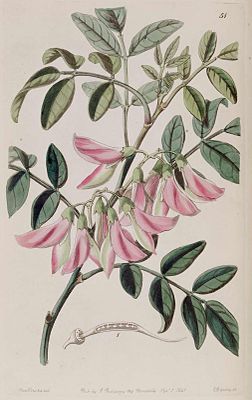Streblorrhiza speciosa
| Streblorrhiza speciosa | ||||||||||||
|---|---|---|---|---|---|---|---|---|---|---|---|---|

Streblorrhiza speciosa |
||||||||||||
| Systematics | ||||||||||||
|
||||||||||||
| Scientific name | ||||||||||||
| Streblorrhiza speciosa | ||||||||||||
| Final |
Streblorrhiza speciosa (English common name : "Phillip Island Glory Pea") is an extinct plant species which, along with the endangered taxa Hibiscus insularis and Elymus multiflorus kingianus, was one of the three endemic plant taxa on Phillip Island .
Streblorrhiza speciosa was the only type of monotypic genus Streblorrhiza within the family of legumes (Fabaceae). This plant species was discovered in 1804 by the Austrian plant illustrator Ferdinand Bauer (1760–1826) and scientifically described in 1833 by Stephan Ladislaus Endlicher .
description
Streblorrhiza speciosa was a climbing plant . The stem axis was bare. The smooth, evergreen, odd pinnate leaves composed of five to seven pinna leaflet . The elliptical leaflets were 2.5 to 4 inches long and 1 to 2 inches wide. The stipules were broadly triangular.
The racemose inflorescence was lateral. The triangular bracts were 1 millimeter long and were quickly thrown off. The cover sheets were tiny. The flower stalks were about 5 millimeters long. The zygomorphic flowers were five-fold with a double flower envelope . The calyx was bell-shaped, the top of the five calyx teeth were triangular, 1 to 2 millimeters long and ciliate. The flower crowns were 3 to 6 inches long and shaped like a parrot's beak. The pink flags were 2 to 2.5 inches long and more or less circular. The wings were 1.5 to 2 inches long and the curved boat was 2 to 2.5 inches long; both were roughly lanceolate with a pointed top and nailed. 4 to 4.5 centimeters long, laterally flattened, elliptically elongated legumes were formed, which contained seeds about 1 centimeter long.
die out
Streblorrhiza speciosa was extinct in the wild in 1830 after the English botanist Allan Cunningham picked up the last specimens. The causes of the extinction were probably overgrazing by feral pigs, domestic goats and rabbits. Because of its attractive legumes , this species has also been seen in British greenhouses. However, since the plants could not survive in cultivation, all specimens were perished by 1860. Today only a few specimens remain, two of them in the Natural History Museum Vienna . In 1980 an attempt was made to germinate seeds from the preserved legume of the type specimen , but this attempt was unsuccessful.
swell
- PB Heenan: Relationships of Streblorrhiza (Fabaceae), an extinct monotypic genus from Phillip Island, South Pacific Ocean , In: New Zealand Journal of Botany , 2001, Volume 39, pp. 9-15: full text PDF.
- Flora of Australia Online - Streblorrhiza speciosa
Individual evidence
- ↑ Streblorrhiza speciosa in the IUCN Red List of Threatened Species 2013.1. Listed by: World Conservation Monitoring Center, 1998. Retrieved September 21, 2013.